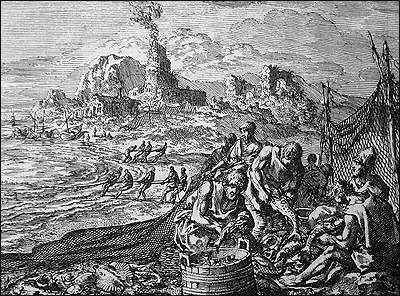
Home > Jesus > Parables of Jesus > Parable of the Dragnet
 Parable of the Dragnet
Parable of the Dragnet
“Again, the kingdom of heaven is like a dragnet cast into the sea, and gathering fish of every kind; 48 and when it was filled, they drew it up on the beach; and they sat down and gathered the good fish into containers, but the bad they threw away. 49 So it will be at the end of the age; the angels will come forth and take out the wicked from among the righteous, 50 and will throw them into the furnace of fire; in that place there will be weeping and gnashing of teeth. — Matthew 13:47-50, NASB
The parable of the dragnet follows the similar parable of the tares in Matthew and refers to the final judgments. While the example of wheat and tares in a field signifies the coexistence of believers and nonbelievers in the present age, here God’s judgment of mankind in the last days is emphasized—illustrated as a dragnet deployed in a sea representing the whole of humanity. In the same way that everything in the water is surrounded by the net, all people are subject to God’s holy standard and the authority of His judgment.
The Greek word used here for net is sagene, which describes a type of very large weighted net designed to encircle an extremely wide area. When drawn in, it would capture everything indiscriminately. It was operated by a group of fishermen who would also retrieve and sort everything caught up in the net, including the edible and inedible fish, throwing away the bad and setting aside the good.
As the dragnet in the analogy gathers “fish of every kind,” every kind of person will be collected in the net of God’s judgment, whether good, bad, believer, nonbeliever, lukewarm or indifferent to the message of the gospel. At the end of the present church age the net will be filled and finally drawn in. Collecting all of humanity are God’s angels who sort the truly saved and unsaved for separate fates. No one will elude the drawing in of the net.
We know from elsewhere in scripture that saved believers will experience the bema, or judgment seat of Christ, where they will give an account of themselves to God, have their works on Earth evaluated, and be rewarded accordingly. That judgment does not determine salvation. Believers through faith have already received salvation by Christ's completed work on the cross; their transgressions have been bought and paid for by His blood.
The remainder and majority will face the great white throne judgment described in Revelation 20:11-15. Though some may have associated with Christianity, as nonbelievers they find themselves unredeemed by Christ’s sacrifice, will be found absent from the book of life and must be judged solely according to their works along with the rest of the reprobate. They will be found deficient in comparison to God’s holy standard and will be sentenced to eternal damnation. The judgment is certain and final.
Though the dragnet surrounds us, it has not yet been drawn in to shore. There remains some time for the unregenerate to repent, to recognize and receive God’s truth and eternal life through Christ Jesus. His death and resurrection is the means through which His righteousness is ascribed to all true believers, making them acceptable to the Father. Is your faith indeed saving faith? Consider the question, and be found in the book of life when the net draws to shore.
Image:
Luyken, Jan (1649-1712); Parable of the Dragnet; Medhurst, Phillip (attribution)
Scripture Alone • Faith Alone • Grace Alone • Christ Alone • To the Glory of God Alone
Most scripture quotations taken from the New American Standard Bible® (NASB)